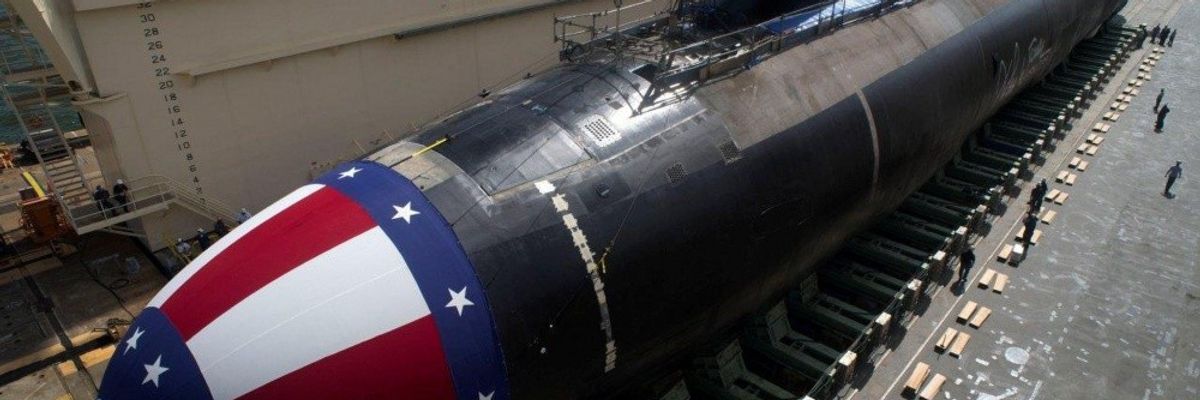When I walked across the brow of the U.S.S. Topeka for the last time in March 2000, it was a nuclear-powered submarine in the Los Angeles class. I served four years in the vessel’s reactor compartment as a nuclear reactor operator. At the time, the vessel did not carry any nuclear missiles.
Now, a decision to add them to the Topeka and other similar submarines risks the lives of the submariners on board and the American people.
During my service, the Navy used two types of nuclear submarines. The ballistic submarine, intended to act as a deterrent to any pre-emptive nuclear strike by another country with nuclear capabilities, and the fast attack submarine, designed to spy and gather surveillance. In 2018, the Trump administration considered retrofitting in-service fast attack submarines with nuclear weapons. Today, nuclear submarines have, once again, become a hot topic, with $25 million allocated to so-called "low-yield" sea-launched cruise missiles (SLCM-Ns) in the FY23 National Defense Authorization Act. The House passed the NDAA but the Senate, the eventual conference committee between the two, and the appropriations committees all have opportunities to help stop this. Depending on the outcome, future submariners' lives may become more imperiled.
Submarines carried nuclear devices from 1959 until 1991, when President George H. W. Bush ordered the withdrawal of all tactical nuclear-armed sea-launched cruise missiles from submarines. In 2010, the Obama administration recommended the Navy retire its nuclear cruise missiles, stating that the United States could continue to support its allies in Asia without these missiles, and the Navy completed their retirement in 2013. In 2018, the Trump administration issued its Nuclear Posture Review, focusing on eliminating perceived gaps in the U.S. nuclear arsenal and proposing the redeployment of nuclear cruise missiles on Navy submarines.
In 2022, the Biden administration sent its Nuclear Posture Review to Congress, with the cancellation of SLCM-Ns as a top priority. However, despite both Biden and Navy officials opposing the SLCM-N, other actors in Congress want to see these missiles stay.
There are numerous reasons to discontinue the use of SLCM-Ns with a primary one being its price tag. As of 2019, it was estimated that the missile program would cost $9 billion from 2019-2028. This projection does not account for production costs after 2028, nor does it factor in costs associated with integrating the missiles on ships.
Another reason is that the United States already has a wide array of non-strategic nuclear capabilities, making SLCM-Ns unnecessary. From heavy bombers equipped to carry gravity bombs, to air-launched cruise missiles, to short-range fighter jets, the allocation of funds to the development of SLCM-Ns is redundant. Additionally, funding the SLCM-N program will impact conventional Navy missions and the vital work being done on these vessels at present.
Finally, nuclear submarines pose numerous hazards to those on board. The sailors aboard these vessels face risks from high voltage electricity, high pressure air and water, and various toxic chemicals. Any major accident onboard a vessel could cause the entire crew to be lost at sea. Additionally, while nuclear-powered submarines are configured to mitigate most radiation exposure, there is still some opportunity for those on board to be exposed.
Perhaps the greatest risk of working aboard a nuclear submarine is the disastrous consequences of using a nuclear missile. The use of one nuclear weapon has exponential effects, which risk the lives of everyone across the globe. When sailors take their oaths upon entering the military, they commit to protecting their fellow citizens. However, the dangers posed by the use of SLCM-Ns run counter to this mission.
Presently, the United States military has a well-equipped stockpile of nuclear weapons. The allocation of funds to the development of SLCM-Ns, to serve as a so-called “deterrent” to an initial nuclear strike, is an unnecessary use of taxpayer money that carries large risks for the American public. Why expose future submariners, who already face many dangers, to the presence of nuclear bombs? What could the billions of dollars currently proposed for these submarines be used for instead? It is time to take SLCM-Ns off the table, and retire them for good.



 Top photo credit: Ngô Đình Diệm after being shot and killed in the 1963 coup (US National Archives)
Top photo credit: Ngô Đình Diệm after being shot and killed in the 1963 coup (US National Archives) 












